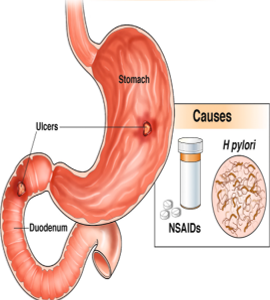Download English PDF, 636KB, PDF
What is Peptic Ulcer Disease (PUD)?
Peptic Ulcer Disease (PUD) is a condition where an ulcer is created because of a break in the inside lining of your stomach or upper portion of your small intestine (duodenum).
Peptic ulcers that occur on the inside of your stomach are called gastric ulcers. If they occur on the inside of your duodenum, upper portion of your small intestine, they are called duodenal ulcers.
Two Major Causes of PUD:
-
Infection by bacteria Helicobacter pylori (H. pylori)
The inner lining of the stomach or duodenum becomes swollen and painful after infection.
-
Nonsteroidal Anti-Inflammatory Drugs (NSAIDs)
The lining of the stomach and duodenum become irritated after taking NSAIDs. These are pain medications, and common ones include naproxen, aspirin and ibuprofen.

“Peptic ulcers caused by PUD”
What Can Increase Risk of PUD?

Family History: If your family members have peptic ulcers, you are more likely to develop these ulcers too.

Excessive Alcohol: This can irritate stomach lining and increase stomach acid production.

Smoking: Peptic ulcers are more likely to form, and take a longer time to heal.
What Are the Symptoms of PUD?
You may or may not experience the following:
- Upper abdominal pain or discomfort (often a burning or hunger-like feeling
- Feeling full quickly when eating
- Stomach pain, belching/burping, or feeling bloated after eating
- Heartburn or acid reflux (both are burning feelings in the middle of the chest)
- Nausea
- vomiting (in severe cases, there may be blood in the vomit)
- Blood in stools (appear black or tar-like)
Do note that the elderly commonly do not experience any symptoms.
How Is PUD Diagnosed?
Some of the peptic ulcer symptoms may also be caused by other digestion-related conditions. Do see your doctor for advice.
You may be required to undergo some tests for confirmation, such as:
-
Gastroscopy – an endoscope (thin flexible tube with lens) is inserted through your mouth to look for ulcers in your throat, food pipe and stomach.
-
Barium Swallow – drinking a thick liquid containing barium (white powder) to make an ulcer more visible through X-ray images.
These test are generally safe and serious complications are rare.
What Are the Treatment Options?
Depending on the cause of the ulcers, treatments could be:

1) Antibiotic medications - kill H. pylori

2) Medications - block acid production and promote healing, such as omeprazole and famotidine
What Else Do I Need to Know?
1) Abdominal Pain
Duodenal ulcers may cause abdominal pain several hours after eating (often during the night). This is because there is no food in the digestive tract for the stomach acid to work on.
Eating a meal, drinking milk or taking an antacid may help to relieve your symptoms.
2) Alternative Medications to NSAIDs
If you are on NSAIDS, your doctor may recommend alternative medications.
3) Urea Breath Test
If your ulcer was due to H. pylori, your doctor may do a urea breath test. This is to confirm that the infection is gone after a course of antibiotic medication.
